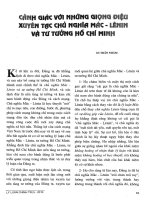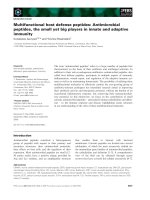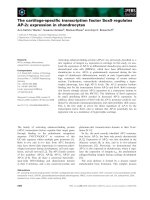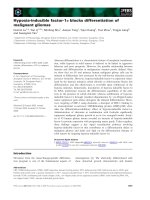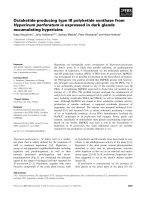báo cáo khoa học:" Salivary flow rate, pH, and concentrations of calcium, phosphate, and sIgA in Brazilian pregnant and non-pregnant women" pdf
Bạn đang xem bản rút gọn của tài liệu. Xem và tải ngay bản đầy đủ của tài liệu tại đây (246.43 KB, 5 trang )
BioMed Central
Page 1 of 5
(page number not for citation purposes)
Head & Face Medicine
Open Access
Research
Salivary flow rate, pH, and concentrations of calcium, phosphate,
and sIgA in Brazilian pregnant and non-pregnant women
Maria I Rockenbach*
†1
, Sandra A Marinho
†2
, Elaine B Veeck
†1
,
Laura Lindemann
†3
and Rosemary S Shinkai
†4
Address:
1
Department of Oral Surgery, Pontifical Catholic University of Rio Grande do Sul, Porto Alegre, Brazil,
2
Graduate Program in Oral
Medicine, Pontifical Catholic University of Rio Grande do Sul, Porto Alegre, Brazil,
3
Private practice, Porto Alegre, Brazil and
4
Department of
Prosthodontics, Pontifical Catholic University of Rio Grande do Sul, Porto Alegre, Brazil
Email: Maria I Rockenbach* - ; Sandra A Marinho - ; Elaine B Veeck - ;
Laura Lindemann - ; Rosemary S Shinkai -
* Corresponding author †Equal contributors
Abstract
Background: Studies on salivary variables and pregnancy in Latin America are scarce. This study
aimed to compare salivary flow rate, pH, and concentrations of calcium, phosphate, and sIgA of
unstimulated whole saliva in pregnant and non-pregnant Brazilians.
Methods: Cross-sectional study. Sample was composed by 22 pregnant and 22 non-pregnant
women attending the Obstetrics and Gynecology Clinics, São Lucas Hospital, in Porto Alegre city,
South region of Brazil. Unstimulated whole saliva was collected to determine salivary flow rate, pH,
and biochemical composition. Data were analyzed by Student t test and ANCOVA (two-tailed α =
0.05).
Results: No difference was found for salivary flow rates and concentrations of total calcium and
phosphate between pregnant and non-pregnant women (p > 0.05). Pregnant women had lower pH
(6.7) than non-pregnant women (7.5) (p < 0.001), but higher sIgA level (118.9 mg/L) than the latter
(90.1 mg/L) (p = 0.026).
Conclusion: Some of the tested variables of unstimulated whole saliva were different between
pregnant and non-pregnant Brazilians in this sample. Overall, the values of the tested salivary
parameters were within the range of international references of normality.
Background
Hormonal changes in females may affect the physiology
of the entire body including the oral cavity. Besides the
direct effect on the metabolism of periodontal tissues,
pregnancy, menstruation, and hormone replacement
therapy may induce short-term changes in salivary flow
rates, buffering capacity, and biochemical composition
[1-5]. Changes in salivary composition and flow rates may
compromise the integrity of the soft and hard tissues in
the oral cavity, because saliva functions include food and
bacteria clearance, mastication and digestion, lubrication,
antimicrobial defense, and buffering effect [6,7]. Saliva is
composed of water and organic and inorganic molecules,
but a large intra- and inter-subject variability in composi-
tion is reported [2,6].
Published: 28 November 2006
Head & Face Medicine 2006, 2:44 doi:10.1186/1746-160X-2-44
Received: 20 February 2006
Accepted: 28 November 2006
This article is available from: />© 2006 Rockenbach et al; licensee BioMed Central Ltd.
This is an Open Access article distributed under the terms of the Creative Commons Attribution License ( />),
which permits unrestricted use, distribution, and reproduction in any medium, provided the original work is properly cited.
Head & Face Medicine 2006, 2:44 />Page 2 of 5
(page number not for citation purposes)
Most studies focusing on the influence of pregnancy and
hormonal alterations on salivary characteristics were per-
formed in European countries, and some reference stand-
ards for normality [6,8] are derived from data obtained in
specific populations. The Latin American literature on this
topic is scarce. A preliminary search of the electronic data-
base Latin American and Caribbean Literature on the
Health Sciences (LILACS) using the terms "saliva" and
"pregnancy" resulted in eleven articles published in the
last 20 years, and only one evaluated salivary flow rates
and/or pH in pregnant women [9]. A similar search of
PubMed MEDLINE yielded another study in Latin Ameri-
can women [10]. Therefore, it is difficult to compare
results from populations with potential differences of
genetics and dietary habits.
This cross-sectional study aimed to compare the salivary
flow rates, pH, and concentrations of calcium, phosphate,
and secretory immunoglobulin A (sIgA) of the unstimu-
lated whole saliva in pregnant and non-pregnant women,
residents in the metropolitan area of Porto Alegre city, in
the South region of Brazil. The a priori hypothesis was
that there are differences of salivary flow rate, pH, and
biochemical composition of saliva between pregnant and
non-pregnant women.
Methods
A convenience sample was composed of 44 women aged
between 18 and 38 years-old, selected among the patients
attending the Obstetrics and Gynecology Clinics, São
Lucas Hospital, in Porto Alegre city, South region of Bra-
zil. All of the subjects were healthy, functioning individu-
als attending the clinics for regular exam, with no
complaint of xerostomia. Twenty-two consecutive preg-
nant women (mean age: 27.9 years-old), between the fifth
and ninth month of pregnancy, comprised the pregnant
group. Exclusion criteria were high-risk pregnancy and
unwillingness to participate in the study. The comparison
group was composed of 22 non-pregnant women (mean
age: 29.5 years-old), who attended the same clinics for
routine exam. The research protocol was in compliance
with the Helsinki Declaration and was approved by the
institutional review board of the Pontifical Catholic Uni-
versity of Rio Grande do Sul. All subjects signed an
informed consent form before the study procedures.
A structured questionnaire was used to collect data on oral
hygiene habits (frequency of tooth brushing, use of dental
floss), professional counseling on oral health and
hygiene, and presence of gingival bleeding. Data on med-
ical conditions and use of medications were retrieved
from the subject's medical charts.
Sialometrical analysis
The collection of unstimulated whole saliva was per-
formed under resting conditions between 07:30 and
10:30 am, at least 1 h after eating, following standard pro-
cedures [11]. Subjects were asked to sit passively and
expectorate into pre-weighed plastic containers for 5 min
as the saliva accumulated in the floor of the mouth. Sali-
vary samples were collected on ice, and the volume was
determined gravimetrically: The weight of each saliva
sample (g) was equated to volume (mL), since the specific
gravity of saliva is 1.0 [12,13]. Salivary flow rates were
expressed as mL/min.
Sialochemical analysis
Saliva samples were centrifuged (centrifugal force: 1,000
g) to remove bacteria and other extraneous material. The
resulting clarified fluid was used for the biochemical
assays to measure salivary pH and the concentrations of
the following parameters: total calcium, inorganic phos-
phate, and sIgA.
Salivary pH was determined by means of micro-electrodes
of a blood gas analyzer that measured the hydrogen ion
concentration. Salivary pH values were reported as the log
of the mean hydrogen ion activity.
Total calcium was determined using the CPC photometric
method based on the work of Gitelman [14]. Calcium
ions form a violet complex with o-cresolphthalein com-
plexone in an alkaline medium. The reaction is measured
colorimetrically with CPC at 545 nm. The intensity of the
colour is directly proportional to calcium concentration
in the sample.
Inorganic phosphate was determined using the phospho-
molybdate/UV method of Daly and Ertingshausen [15],
which relies on the formation of a UV absorbing complex
between phosphorus and molybdate. Inorganic phospho-
rus reacts with ammonium molybdate in the presence of
sulfuric acid to form an unreduced phosphomolybdate
complex which is measured as an endpoint reaction at
340 nm.
Secretory IgA was measured by a radial-immunodiffusion
method [16] using specific antibodies to form precipita-
tion rings in agarose gels. The diameter of the ring formed
is quantitatively related to the concentration of the sali-
vary parameter analyzed.
Statistical analysis
Data were analyzed by descriptive statistics, and compari-
sons between the pregnant and non-pregnant groups were
performed using Student t test for independent samples
for salivary flow rate and analysis of covariance
(ANCOVA) for salivary pH, and concentrations of cal-
Head & Face Medicine 2006, 2:44 />Page 3 of 5
(page number not for citation purposes)
cium, phosphate, and sIgA. For ANCOVA, the fixed factor
was pregnancy status (pregnant vs. non-pregnant) and the
covariate was salivary flow rate. All statistical tests were
two-tailed, and a P-value of 0.05 was considered statisti-
cally significant for rejection of the null hypothesis.
Results
Pregnant women had lower salivary pH (6.7) than non-
pregnant women (7.5) (p < 0.001), but higher sIgA level
(118.9 mg/L) than the latter (90.1 mg/L) (p = 0.026). Sal-
ivary flow rates and levels of total calcium and phosphate
were not statistically different between pregnant and non-
pregnant women (p > 0.05) (Table 1). All values were
within the international references of normality (Table 2).
In relation to oral hygiene habits, 16 pregnant (73%) and
15 non-pregnant (68%) patients used to brush their teeth
at least three times a day. Most women (16 pregnant
[73%] and 17 non-pregnant [77%]) had received profes-
sional orientation of oral hygiene care and followed these
recommendations, but some did not use dental floss (9
pregnant [41%] and 4 non-pregnant [18%] women). The
pregnant patients who did not use dental floss had gingi-
val bleeding, and two of them reported that the bleeding
started during the gestational period.
Regarding intake of medication, 11 pregnant and 15 non-
pregnant women did not use any medication. Some preg-
nant women under medication reported use of ferrous
sulphate and analgesics. Non-pregnant women used
mainly oral contraceptives; analgesics also were recorded.
Discussion
In this sample salivary pH and concentration of sIgA were
different between pregnant and non-pregnant Brazilians,
but no significant difference was found for salivary flow
rates of unstimulated whole saliva or concentrations of
calcium and phosphate. We chose to collect unstimulated
whole saliva because this type of saliva predominates dur-
ing most part of the day and is important for maintenance
of oral health, reflecting a physiological status of the oral
cavity and of the entire body [17]. However, collection of
true unstimulated saliva is difficult due to interferences of
environmental stimuli, which may determine a broad
range of salivary flow rates. For this reason, some research-
ers prefer to use stimulated saliva. In an update review on
saliva for the FDI, it was stressed that the limits of the nor-
mal reference range of flow rates of saliva are still contro-
versial [17]. Although we followed standard procedures
for collection of saliva samples [11], we found a broad
range of salivary flow rates for unstimulated whole saliva,
which could potentially affect our results. For example,
Rudney [2] reported that the concentration of slgA is neg-
atively correlated with flow rate in unstimulated whole
saliva and in either weakly or strongly stimulated parotid
saliva. Furthermore, the influence of salivary flow rate on
biochemical composition may be different according to
the pregnancy status as Kivela et al. [18] found that the
concentration of salivary carbonic anhydrase VI had a
weak positive correlation with flow rate in late pregnancy
but not in postpartum. Because there was a numerical
trend of higher salivary flow rate in the non-pregnant
group, we compared the pregnant and non-pregnant
groups adjusting for salivary flow rate by using analysis of
covariance for salivary pH, and concentrations of calcium,
phosphate, and sIgA. Therefore, we removed any possible
variation attributable to flow rate from the other variables
[2].
In our study, as salivary flow rates did not differ with preg-
nancy status, we checked the medications taken by the
study subjects to rule out any possible drug-related reduc-
tion of salivary flow rates [19]. Most non-pregnant
women were taking oral contraceptives, but secretion rate
of saliva does not seem to be affected by intake of this type
of drug [20] or by estrogen status [21]. Previous studies
with unstimulated and stimulated whole saliva also did
not show any significant modifications of flow rates dur-
ing pregnancy or in the post-partum period [22,23]. Con-
versely, some studies did find lower salivary flow rates in
pregnant women compared with non-pregnant women
Table 1: Salivary flow rate, pH, and concentrations of calcium, phosphate, and sIgA in pregnant and non-pregnant women.
Variable Pregnant (n = 22) Non-pregnant (n = 22) P*
Mean SD Mean SD
Salivary flow rate (mL/min) 0.59 0.37 0.64 0.33 0.652
PH 6.7 0.4 7.5 0.4 <0.001
Calcium (mmol/L) 1.1 0.3 0.9 0.4 0.252
Phosphate (mmol/L) 5.6 1.9 5.6 2.3 0.803
sIgA (mg/L) 118.9 47.0 90.1 35.0 0.026
* Student t test for independent samples (for salivary flow rate) and ANCOVA (for salivary pH, and concentrations of calcium, phosphate, and sIgA;
covariate: salivary flow rate), two-tailed α = 0.05.
Head & Face Medicine 2006, 2:44 />Page 4 of 5
(page number not for citation purposes)
[9,24], but all values of salivary flow rates were within the
accepted normal range.
Although no difference of salivary flow rates was observed
between the two groups, salivary pH was lower in preg-
nant (6.7) than in non-pregnant (7.5) women. In the lat-
ter, salivary pH was marginally above the upper limit of
normality (7.4) according to international references.
These values are similar to those reported by González et
al. [9] for stimulated saliva in pregnant (pH 6.6) and non-
pregnant Mexicans (pH 7.1). Laine and Pienihäkkinen
[22] also found that the salivary buffer effect increased sig-
nificantly from late pregnancy to postpartum, but this
change was not related to salivary flow rates, since both
unstimulated and paraffin-stimulated flow rates remained
unchanged.
We did not find any difference in the concentrations of
calcium and phosphate between the pregnant and non-
pregnant groups despite the difference in salivary pH.
Laine [3] also stated that pregnancy per se does not induce
significant withdrawal of calcium or other minerals from
the teeth. On the other hand, Salvolini et al. [1] reported
a significant decrease of calcium levels between the 21st
and the 40th week of gestation in relation to controls, and
a decrease of phosphate at the 21st week. Other studies
have reported a direct relation between increase of pH and
increase of concentration of sodium and bicarbonate in
saliva [25,26]. However, the possible regulatory mecha-
nism of electrolyte and mineral composition of saliva
remains unclear.
In relation to sIgA, we found higher levels of sIgA in preg-
nant women, but the difference between the two groups
(pregnant: 119.8 mg/L versus non-pregnant; 90.1 mg/L)
was minor. Secretion and synthesis of sIgA may be
affected by stress, physical exercises, medications, men-
strual cycle, and pregnancy [27]. The hormonal changes
during pregnancy may have altered the sIgA levels because
the production of estrogen and progesterone increases
gradually until the eighth month of pregnancy, and both
hormones modulate the immune system during the gesta-
tional period [3]. Widerström and Bratthall [24] also
found increase of salivary concentration of sIgA during
pregnancy, delivery and post-partum period, but not in
non-pregnant women during the several phases of the
menstrual cycle. As salivary flow rate of pregnant women
was slightly lower than that of non-pregnant counterparts,
the authors suggested that the increased level of sIgA was
not influenced by salivary flow rate. This relation was also
observed in our results. In our sample, because of the neg-
ligence of some pregnant patients with oral hygiene, the
concentration of sIgA may also have increased due to an
increase of the number of oral microorganisms as sIgA is
the main adaptive immune mechanism in the oral cavity
[27].
The cross-sectional design of this study does not allow
inference of causal relationships, but our data corroborate
some results of previous studies conducted in other parts
of the world. Overall, the values of salivary variables ana-
lyzed in this sample of pregnant and non-pregnant Brazil-
ians did not differ from values reported for other
populations and were within the international references
of normality. Nevertheless, it should be noted that the
interval of these reference values is considerably large,
reflecting the large variation that is considered to be
within the normal range. Therefore, it seems to be difficult
to use some of these salivary parameters, e.g., salivary con-
centrations of sIgA or phosphate, as outcome measures or
biomarkers to diagnose systemic disease and monitor
general health [28] unless the condition under investiga-
tion leads to large alterations of concentration. The differ-
ences between pregnant and non-pregnant women
Table 2: Contrast of the values of the tested salivary variables with reference standards of normality.
Variable Minimum Maximum Mean 95% Confidence interval Normal reference values
Pregnant (n = 22)
Flow rate (mL/min) 0.12 1.73 0.59 [0.43–0.75] 0.1 – 0.5*
PH 5.9 7.6 6.7 [6.5–6.9] 5.5 – 7.4**
Calcium (mmol/L) 0.5 1.8 1.1 [0.9–1.2] 0.5 – 2.7 *
Phosphate (mmol/L) 2.4 9.1 5.6 [4.8–6.5] 1.9 – 22.9 *
sIgA (mg/L) 12.0 185.0 118.9 [98.0–139.7] 60 – 300 ***
Non-Pregnant (n = 22)
Flow rate (mL/min) 0.20 1.53 0.64 [0.50–0.78] 0.1 – 0.5 *
PH 6.6 8.0 7.5 [7.3–7.6] 5.5 – 7.4**
Calcium (mmol/L) 0.4 1.8 0.9 [0.8–1.1] 0.5 – 2.7 *
Phosphate (mmol/L) 2.6 12.7 5.6 [4.6–6.7] 1.9 – 22.9 *
sIgA (mg/L) 34.0 173.0 90.1 [74.6–105.6] 60 – 300 ***
*Edgar (1992); **Thylstrup & Fejerkov (1994); ***Dade Behring
®
Publish with BioMed Central and every
scientist can read your work free of charge
"BioMed Central will be the most significant development for
disseminating the results of biomedical research in our lifetime."
Sir Paul Nurse, Cancer Research UK
Your research papers will be:
available free of charge to the entire biomedical community
peer reviewed and published immediately upon acceptance
cited in PubMed and archived on PubMed Central
yours — you keep the copyright
Submit your manuscript here:
/>BioMedcentral
Head & Face Medicine 2006, 2:44 />Page 5 of 5
(page number not for citation purposes)
detected in our study and in previous papers are small in
absolute values and would not impact clinical manage-
ment of oral health in these groups. However, this situa-
tion may change when evaluating the effect of high-risk
pregnancy in medically-compromised women on some
salivary parameters.
Conclusion
In summary, pregnant women had lower pH and higher
sIgA concentration than non-pregnant women in this
sample, but no significant difference was found for secre-
tion rate of saliva or concentrations of calcium and phos-
phate. The values of the tested salivary parameters were
within the international references of normality.
Competing interests
The author(s) declare that they have no competing inter-
ests.
Authors' contributions
MIR and SAM performed the data collection, data analy-
sis, and wrote the manuscript. EBV conceived the study
and its design. LL participated in the design of the study.
RSS participated in the data analysis and preparation of
the manuscript. All authors read and approved the final
version of the manuscript.
Acknowledgements
We thank Stela Krapf and Ana Lígia Bender, Laboratory of Clinical Pathol-
ogy, São Lucas Hospital, for their technical support in the biochemical
assays, Dr. Mariângela Badalotti, Chair of the Department of Obstetrics and
Gynecology, São Lucas Hospital, for helping in the enrollment of the study
subjects, and Dr. Chih-Ko Yeh, from the University of Texas Health Science
Center, for the suggestions for the final version of this manuscript.
References
1. Salvolini E, Di Giorgio R, Curatola A, Mazzanti L, Fratto G: Biochem-
ical modifications of human whole saliva induced by preg-
nancy. Br J Obstet Gynaecol 1998, 105:656-660.
2. Rudney JD: Does variability in salivary protein concentrations
influence oral microbial ecology and oral health? Crit Rev Oral
Biol Med 1995, 6:343-367.
3. Laine MA: Effect of pregnancy on periodontal and dental
health. Acta Odontol Scand 2002, 60:257-264.
4. Choe JK, Khan-Dawood FS, Dawood MY: Progesterone and
estradiol in the saliva and plasma during the menstrual cycle.
Am J Obstet Gynecol 1983, 147:557-562.
5. Laine M, Leimola-Virtanen R: Effect of hormone replacement
therapy on salivary flow rate, buffer effect and pH on peri-
menopausal and postmenopausal women. Arch Oral Biol 1996,
41:91-96.
6. Edgar WM: Saliva: its secretion, composition and functions. Br
Dent J 1992, 172:305-312.
7. Pedersen AM, Bardow A, Jensen SB, Nauntofte B: Saliva and gas-
trointestinal functions of taste, mastication, swallowing and
digestion. Oral Dis 2002, 8:117-129.
8. Thylstrup A, Fejerskov O: Textbook of Clinical Cariology Copenhagen:
Munksgaard; 1994.
9. González M, Montes de Oca L, Jiménez G: [Changes in saliva com-
position of pregnant and non-pregnant patients]. Perinatol
reprod hum 2001, 15:195-201. Spanish
10. D'Alessandro S, Curbelo HM, Tumilasci OR, Tessler JA, Houssay AB:
Changes in human parotid salivary protein and sialic acid lev-
els during pregnancy. Arch Oral Biol 1989, 34:829-831.
11. Atkinson JC: The role of salivary measurements in the diagno-
sis of salivary autoimmune diseases. Ann N Y Acad Sci 1993,
694:238-251.
12. Shannon IL: Reference for human parotid saliva collected at
varying levels of exogenous stimulation. J Dent Res 1973,
52:1157.
13. Banderas-Tarabay JA, Gonzalez-Begne M, Sanchez-Garduno M, Mil-
lan-Cortez E, Lopez-Rodriguez A, Vilchis-Velazquez A: [The flow
and concentration of proteins in human whole saliva]. Salud
Publica Mex 1997, 39:433-441. Spanish
14. Gitelman HJ: An improved automated procedure for the
determination of calcium in biological specimens. Anal Bio-
chem 1967, 18:521-531.
15. Daly JA, Ertingshausen G: Direct method for determining inor-
ganic phosphate in serum with the "CentrifiChem". Clin Chem
1972, 18:263-265.
16. Mancini G, Carbonara AO, Heremans JF: Immunochemical quan-
titation of antigens by single radial immunodiffusion. Immun-
ochemistry 1965, 2:235-254.
17. Sreebny LM: Saliva in health and disease: an appraisal and
update. Int Dent J 2000, 50:140-161.
18. Kivela J, Laine M, Parkkila S, Rajaniemi H: Salivary carbonic anhy-
drase VI and its relation to salivary flow rate and buffer
capacity in pregnant and non-pregnant women. Arch Oral Biol
2003, 48:547-551.
19. Scully C, Bagan JV: Adverse drug reactions in the orofacial
region. Crit Rev Oral Biol Med 2004, 15:221-239.
20. Laine M, Pienihakkinen K, Ojanotko-Harri A, Tenovuo J: Effects of
low-dose oral contraceptives on female whole saliva. Arch
Oral Biol 1991, 36:549-552.
21. Streckfus CF, Baur U, Brown LJ, Bacal C, Metter J, Nick T: Effects of
estrogen status and aging on salivary flow rates in healthy
Caucasian women. Gerontology 1998, 44:32-39.
22. Laine M, Pienihäkkinen K: Salivary buffer effect in relation to
late pregnancy and postpartum. Acta Odontol Scand 2000,
58:8-10.
23. Laine M, Tenovuo J, Lehtonen OP, Ojanotko-Harri A, Vilja P, Tuohi-
maa P: Pregnancy-related changes in human whole saliva.
Arch Oral Biol 1988, 33:913-917.
24. Widerstrom L, Bratthall D: Increased IgA levels in saliva during
pregnancy. Scand J Dent Res 1984, 92:33-37.
25. Mandel ID: Sialochemistry in diseases and clinical situations
affecting salivary glands. Crit Rev Clin Lab Sci 1980, 12:321-366.
26. Dawes C: Factors influencing salivary flow rate and composi-
tion. In Saliva and oral health 3rd edition. Edited by: Edgar M, Dawes
C, O'Mullane D. London: British Dental Association; 2004:32-49.
27. Teeuw W, Bosch JA, Veerman EC, Amerongen AV: Neuroendo-
crine regulation of salivary IgA synthesis and secretion:
implications for oral health. Biol Chem 2004, 385:1137-1146.
28. Lawrence HP: Salivary markers of systemic disease: noninva-
sive diagnosis of disease and monitoring of general health. J
Can Dent Assoc 2002, 68:170-174.


